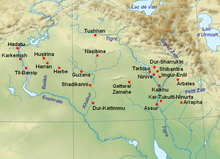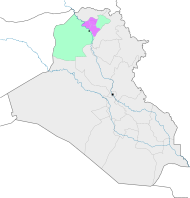Balawat
ܒܝܬ ܠܒܬ | |
 | |
| Location | Nineveh Governorate, Iraq |
|---|---|
| Region | Northern Mesopotamia |
| Coordinates | 36°13′46″N 43°24′12″E / 36.22944°N 43.40333°E on |
| Site notes | |
| Excavation dates | 1878, 1956, 1989 |
| Archaeologists | Hormuzd Rassam, M. Mallowan, D.J. Tucker |
Balawat (
Ancient name
Balawat is the site of the ancient Assyrian city of Imgur-Enlil. The meaning of Imgur-Enlil is "Enlil agreed". Note that there was also a wall in ancient Babylon named Imgur-Enlil.[1]
History of archaeological research

The site was excavated in 1878 by archaeologist
Occupation history
The city of Imgur-Enlil was founded by the Neo-Assyrian king
Post U.S.-Iraq War construction
In November 2004, the village had roads constructed by the
Material culture

Aside from temples and palace buildings, the most important artifacts discovered there were the so-called Balawat Gates. The gates measured about 20 feet in height and belonged to the temple of Mamu, the god of dreams. These were made up of bronze bands attached through nails to two wooden gates of the palace. The bronze bands depict a sacrifice and war scenes from the campaigns of the Neo-Assyrian king Shalmaneser III (859-824 BC), and were the first depictions of landscape elements (such as trees and mountains) in Assyrian art.[7]
See also
References
- S2CID 191498691.
- ^ [1]Hormuzd Rassam, "Excavations and discoveries in Assyria", In: Transactions of the Society of Biblical Archaeology, vol. 7, pp. 37-58, 1882
- ^ [2]Theophilus G. Pinches, " The bronze gates discovered by Mr. Rassam at Balawat", In: Transactions of the Society of Biblical Archaeology, vol. 7, pp. 83-118, 1882
- ^ [3]Hormuzd Rassam and Robert William Rogers, Asshur and the land of Nimrod, Curts & Jennings, 1897
- S2CID 192082396.
- ^ "Ninewa Village RoadsProject" (PDF). Archived from the original (PDF) on 2006-05-16. Retrieved 2006-05-13.
- JSTOR 4200388.
Further reading
- Billerbeck, A./Delitzsch, F., "Die Palasttore Salmanassars II von Balawat", Erklärung ihrerBilder und Inschriften, BA 6/1, Leipzig, 1908
- J.E. Curtis et al., "The Balawat Gates of Ashurnasirpal II", British Museum Press, 2008, ISBN 978-0-7141-1166-7
- [4]Unger, Eckhard, "Zum Bronzetor von Balawat, Beiträge zur Erklärung und Deutung der assyrischen Inschriften und Reliefs Salmanassars III", Leipzig, Pfeiffer, 1913
- Léonard W. King, "Bronze Reliefs from the Gates of Shalmanezer. King of Assyria BC 860-825", Longman's & Company, 1915
- Seton Lloyd, "Foundations in the Dust", 1947 ISBN 978-0500050385
- [5] Theophilus G Pinches and Walter de Gray Birch, The bronze ornaments of the palace gates of Balawat (Shalmaneser II, B.C. 859-825) edited, with an introduction by Walter de Gray Birch ; with descriptions and translations by Theophilus G. Pinches, Society of Great Russell Street, 1902
- [6]Theophilus G Pinches, "The Balawat Gates and Their Relation to Assyrian Art", The American Art Review, vol. 1, pp. 527-535, 1880


